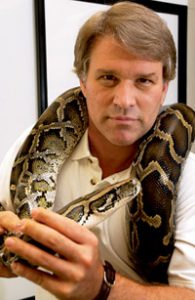Python Research Gives Insight into Digestion
by Chris Bryant

When Dr. Stephen Secor is in social settings and responds to the routinely posed question “So, what do you do for a living?” the answer elicits a mixture of reactions.
That happens when your career focus is python digestion.
“People have a variety of responses,” says Secor, an assistant professor of biological sciences in UA’s College of Arts and Sciences. “Some are so fearful of snakes they don’t even want to talk about it. When I get to the part about what I do in my research, they just back up . . . slowly.”
What Secor does is study the physiological changes that occur as pythons digest their large, and infrequent, meals.
“Digestive physiology is one of the lesser studied of the physiological systems,” Secor said. “There is a lot that is not known about the mechanisms of digestion.” Because digestion is always occurring to some extent in humans and other mammals, it’s more difficult to study and identify what’s happening, physiologically, during the process. That’s where the snakes come in.
Some snakes, including the Burmese pythons that Secor focuses on, undergo extreme changes during digestion.
“An adult python may only eat twice a year or, possibly, once a year,” Secor said. The extent of the changes between periods of fasting and digestion in these cold-blooded animals is enough to make any interested scientist’s warm blood pump a little faster.
While an assistant researcher in the department of physiology in the UCLA School of Medicine, Secor was the lead author of a Nature magazine story, published in October 1998. The story, complete with one of Secor’s pythons snaking its way across the magazine’s cover, details some of the python’s extreme metabolic and physiological changes during digestion.
For example, a python undergoing digestion consumes up to 44 times the amount of oxygen than when fasting. For comparison, this rate of increase is virtually the same as the rate of oxygen consumption increase from a racehorse resting and one galloping, Secor said. In addition, pythons increase their intestines’ ability to transport nutrients, including glucose, by as much as 30 times following feeding.
While humans and most other animals swallow small, finely chewed mouthfuls, pythons swallow large intact prey without chewing and are capable of downing prey equaling their own body mass. That is equivalent, Secor points out, to a 150-pound person consuming more than 300 Big Macs.
Secor, sitting at his desk—with snake skulls lining one row of a shelf to his right, beneath a 14-foot, 6-inch Burmese python skin stretching across his office wall—scrambles to show a visitor magnified images of a python’s intestines. Tiny projections, known as microvilli, line the small intestines of animals. The microvilli of fasting pythons are compared, in the photos, to those of pythons undergoing digestion. There is a four-fold increase.
“Nobody has seen intestinal microvilli lengthen this much in 24 hours,” Secor said. “The key is understanding the mechanism behind it—the mechanism involved in changing the shape of these intestinal cells.”
Studying how pythons regulate glucose transporters has potential implications in the treatment of intestinal disorders and diabetes. As other examples, within two days after eating, python stomach pH drops from seven to one and heart, liver and kidneys increase in mass by 50 to 100 percent—all responses that are reversed when digestion is completed. The study of these phenomena could offer researchers clues to the mechanisms of gastric function and the growth of organs in humans.
And, while for some there could be an “ick” factor to deal with, Secor said viewing the non-venomous pythons as dangerous animals is only the stuff of movies.
“These snakes all have different personalities—just like people do—but, for the most part, they are fairly docile and don’t seem to mind being handled.”
Secor’s 90 pythons, ranging in size from 2 to 12 feet and weighing as much as 70 pounds, are constrictors, meaning they will kill their prey by squeezing it to death before consuming it, although Secor feeds his snakes pre-killed meals, primarily mice and rats.
“People are largely under the impression that pythons crush their prey to death, breaking its bones; in fact the pressure that they do apply during constriction is just enough to inhibit breathing and blood flow to the brain.”
Still, he said he understands why some people get a little queasy when he discusses his work, while others pepper him with questions.
“People are usually either fascinated by snakes or live in complete fear of them.”